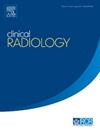Seven-year trends in computed tomography (CT) pulmonary angiography utilisation and predictors of positivity in a large emergency department
IF 2.1
3区 医学
Q2 RADIOLOGY, NUCLEAR MEDICINE & MEDICAL IMAGING
引用次数: 0
Abstract
Aim
To evaluate trends in computed tomography pulmonary angiography (CTPA) utilisation in an emergency department (ED) and identify factors associated with pulmonary embolism (PE) detection.
Materials and Methods
This retrospective study analysed CTPA exams from 2017–2023 at a quaternary urban ED. CTPA volumes were normalised to total ED visits and ED CTs. Logistic regression assessed predictors of positivity. CTPA-per-visit trends were modelled with negative-binomial regression.
Results
CTPA volume rose 49% from 2,467 in 2017 to 3,684 in 2023. Positivity rates remained stable (mean 9.1%, range 8.3%–10.6%, p=0.55). CTPA use peaked at 10.0% of ED CTs in 2021, declining to 8.3% by 2023 (p=0.30). CTPAs per 1,000 ED visits increased from ∼22 in 2017 to ∼40 in 2021, then fell to ∼31 in 2023 (p=0.75). Male patients had higher odds of a positive result (aOR 1.222, 95% CI: 1.115–1.339), as did Black (aOR 1.222, CI: 1.058–1.412) vs White patients. Asian patients had lower odds (aOR 0.647, CI 0.489–0.857). Overnight exams were less likely to yield PE (aOR 0.830, CI 0.730–0.945). Higher body mass index (BMI) (aOR 1.014, CI 1.006–1.022) and cancer history (aOR 1.185, CI 1.039–1.352) were also predictive. Ordering provider training level (MD/DO, NP, PA) did not affect diagnostic yield.
Conclusion
Over a seven-year period (2017–2023), annual CTPA volume and utilisation rate increased, but the positivity rate remained stable at ∼9%. Male sex, Black race, higher BMI, cancer history, and daytime imaging were associated with higher odds of PE. Provider training level was not associated with diagnostic yield.
大型急诊科计算机断层扫描(CT)肺血管造影应用的7年趋势和阳性预测因素
目的评价计算机断层肺血管造影(CTPA)在急诊科(ED)应用的趋势,并确定与肺栓塞(PE)检测相关的因素。材料和方法本回顾性研究分析了2017-2023年在第四纪城市ED的CTPA检查。CTPA量与ED总访问量和ED ct归一化。Logistic回归评估阳性预测因子。每次访问ctpa的趋势用负二项回归建模。结果sctpa数量从2017年的2467个增加到2023年的3684个,增长了49%。阳性率保持稳定(平均9.1%,范围8.3% ~ 10.6%,p=0.55)。CTPA使用率在2021年达到峰值,占ED ct的10.0%,到2023年下降到8.3% (p=0.30)。每1000次ED访问的ctpa从2017年的~ 22增加到2021年的~ 40,然后在2023年下降到~ 31 (p=0.75)。男性患者阳性结果的几率更高(aOR 1.222, 95% CI: 1.115-1.339),黑人患者(aOR 1.222, CI: 1.058-1.412)与白人患者相比也是如此。亚洲患者的患病几率较低(aOR 0.647, CI 0.489-0.857)。隔夜检查不太可能产生PE (aOR 0.830, CI 0.730-0.945)。较高的身体质量指数(BMI) (aOR 1.014, CI 1.006-1.022)和癌症史(aOR 1.185, CI 1.039-1.352)也具有预测作用。订购供应商培训水平(MD/DO, NP, PA)不影响诊断率。结论在2017-2023年的7年期间,CTPA的年用量和使用率有所增加,但阳性率保持稳定在9%左右。男性、黑人、较高的身体质量指数、癌症史和日间影像与PE的高发生率相关。提供者培训水平与诊断率无关。
本文章由计算机程序翻译,如有差异,请以英文原文为准。
求助全文
约1分钟内获得全文
求助全文
来源期刊

Clinical radiology
医学-核医学
CiteScore
4.70
自引率
3.80%
发文量
528
审稿时长
76 days
期刊介绍:
Clinical Radiology is published by Elsevier on behalf of The Royal College of Radiologists. Clinical Radiology is an International Journal bringing you original research, editorials and review articles on all aspects of diagnostic imaging, including:
• Computed tomography
• Magnetic resonance imaging
• Ultrasonography
• Digital radiology
• Interventional radiology
• Radiography
• Nuclear medicine
Papers on radiological protection, quality assurance, audit in radiology and matters relating to radiological training and education are also included. In addition, each issue contains correspondence, book reviews and notices of forthcoming events.
 求助内容:
求助内容: 应助结果提醒方式:
应助结果提醒方式:


